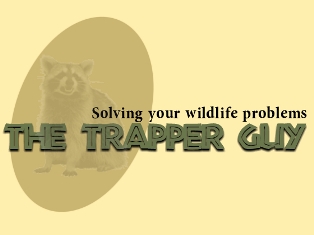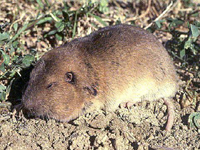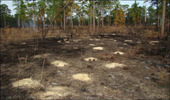| |
|

727-710-0373
Serving
the entire Tampa Bay area
Click
here for a free estimate Pocket
Gophers
Southeastern
Pocket Gophers are located in
the Tampa Bay area northward throughout
the state.
These
critters live underground and
can usually be detected by the
mounds of sandy soil that will
dot your lawn.
Pocket
Gophers, like other wildlife,
are benificial and important to
their eco-system but can be destructive
to your landscape or golf course.
Let
The Trapper Guy help with your pocket gopher removal and control.
Call
today!
727-710-0373
|
Excerpt
from article on Gophers:
Southeastern
Pocket Gopher
William
H. Kern, Jr.
Description
The southeastern pocket gopher, Geomys
pinetis , is also known as the sandy-mounder
or salamander. The pocket gopher is
a rodent that is well adapted for its
life underground. It has very small
eyes and ears and large claws on its
powerful front legs. The term pocket
refers to the fur-lined cheek pouches
that the gopher uses to carry food (Figure
1 ). The old wives' tale that it carries
soil from the burrow in these pouches
is false. The lips close behind the
protruding chisel-like front teeth so
the gopher can chew through dense soil
or large roots without getting dirt
in its mouth. The southeastern pocket
gopher is tan to gray-brown in color.
The feet and naked tail are light colored.
The average total length (tip of nose
to tip of tail) for an adult gopher
is about 10 inches (25 cm), with a range
of 9-12 inches (23-30 cm). Its tail
averages about 3 inches (7.6 cm) in
length.
Habitat and Food
The southeastern pocket gopher requires
deep, well-drained sandy soils. It is
most abundant in longleaf pine/turkey
oak sandhill habitats, but it is also
found in coastal strand, sand pine scrub,
and upland hammock habitats. Gophers
dig extensive tunnel systems and are
rarely seen on the surface. The average
tunnel length is 145 feet (44 m) and
at least one tunnel was followed for
525 feet (159 m). The soil gophers remove
while digging their tunnels is pushed
to the surface to form the characteristic
rows of sand mounds. Mound building
seems to be more intense during the
cooler months, especially spring and
fall, and slower in the summer. In the
spring, pocket gophers push up 1-3 mounds
per day. Based on mound construction,
gophers seem to be more active at night
and around dusk and dawn, but they may
be active at any time of day.
The primary tunnels run parallel to
the surface and most are 2 inches (5
cm) to 2 feet (0.6 m) below the surface,
but some tunnels may extend downward
as far as 5 feet (1.5 m). Nests and
food storage chambers are located in
these deeper tunnels. As the gopher
digs, it pushes the excavated dirt behind
itself. It then turns around in the
tunnel and pushes the dirt up a tunnel
that ends at the surface, producing
a mound. As the main tunnel progresses
beyond the first tunnel, a new lateral
tunnel is dug to the surface. Then the
first lateral tunnel is backfilled to
block it off from the surface. This
behavior is a defense against the gopher's
main predator, the Florida pine snake,
which goes down the tunnel after its
prey. The pine snake kills the gopher
by pressing it against the wall of the
tunnel, rather than wrapping it in constricting
coils.
The pocket gopher feeds on the tap roots,
crown roots, fleshy rhizomes, bulbs,
and tubers of a wide variety of plants
in its natural environment. Bahiagrass
tubers appear to be a preferred food
based on the contents of food caches.
Gophers also have an unfortunate fondness
for sweet potatoes, peanuts, sugarcane,
alfalfa, and peas.
Reproduction
Gophers reach sexual maturity at about
6 months of age. The southeastern pocket
gopher usually has one or two litters
per year. The average number of young
per litter is 1.5 (one to three young).
Although gophers breed year round, breeding
is most common in March and in July
or August. They build nests of shredded
grass in the deepest part of the tunnel
system, 2-5 feet (0.6-1.5 m) below the
surface. The low reproductive rate can
sustain gopher populations because the
gopher has few natural predators, owing
to its underground lifestyle.
Damage and Control
The most common problem associated with
gophers is the numerous large, sandy
mounds they deposit on the surface.
Occasionally, gophers will feed on the
roots or tubers of garden, ornamental,
or crop plants. In natural settings,
gopher tunneling activities are beneficial.
The soil gophers bring to the surface
contains nutrients leached from surface
soils. This natural fertilizer helps
to maintain the sandhill ecosystem.
The mounds of loose soil provide needed
germination sites for some native plant
seeds. Many amphibians and reptiles
use gopher mounds as homes, including
Florida's unique mole skinks. The gopher
tunnels themselves serve as habitat
for many unique invertebrates that are
found nowhere else.
When pocket gophers are damaging lawns,
golf courses, or gardens, it is legal
for the property owners, tenants, or
employees to trap them without a permit.
Because the southeastern pocket gopher
is a native nongame wildlife species,
it is illegal to use any type of poison
(bait or fumigant) to kill it without
a Poison Permit issued by the Florida
Game & Fresh Water Fish Commission
(GFC). If a lawn service or pest control
technician is hired to remove a pocket
gopher, that technician must possess
a Nuisance Wildlife Permit issued by
the GFC.
Trapping
is the most effective method for controlling
the few gophers that invade yards, gardens,
golf courses, or crop fields. Gophers
should be maintained in natural areas
and can usually be tolerated along rights-of-way
for roads and power lines.
Selected
References
Brown, L.N. and G. C. Hickman. 1979.
Tunnel system structure of the southeastern
pocket gopher. Florida Sci. 36:97-103.
Case, Ronald M. 1983. Pocket Gophers.
Prevention and control of wildlife damage.
Coop. Exten. Serv., Univ. Nebraska,
Lincoln. Pp. B.13-B.26.
Daar, Sheila, and William Olkowski.
1985. Tips on gopher control. Common
Sense Pest Control 1(3):18-19.
Wing, E. S. 1960. Reproduction in the
pocket gopher in north-central Florida.
J. Mammal. 41:35-43.
Footnotes
1. This document is WEC-67, one of a
series of the Wildlife Ecology and Conservation
department], Florida Cooperative Extension
Service, Institute of Food and Agricultural
Sciences, University of Florida. First
published as FRC-35, "Controlling
Pocket Gophers," May, 1991. Published
as SS-WIS-67, May, 1994. Reviewed: September,
1998. Please visit the EDIS Web site
at http://edis.ifas.ufl.edu/
2. William H. Kern, Jr., Ph.D., assistant
extension scientist, Largo, FL, 33774,
Cooperative Extension Service, Institute
of Food and Agricultural Sciences, University
of Florida, Gainesville, 32611
|
|
|

Southeastern
Pocket Gopher
Florida native licensed and insured nuisance wildlife
trapper. Let me help you with
your gopher control.
|
| 
Telltale
signs of Pocket Gophers.
|

|
|